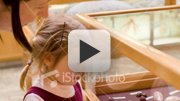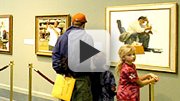OBSERVATION TOOL KIT
An observational toolkit that art museum practitioners could easily access, replicate and implement to better understand how families use and interact with the activities and each other in family-based, interactive spaces was developed as part of the Family Learning in Interactive Galleries [FLING] project. Specifically, the Observation Evaluation: Use and Interaction is designed to measure what differences, if any, exist between the original goals and objectives set forth by museum staff and ways that families actually use and interact with the family galleries.
It is important to note that this observational toolkit is designed to be a guideline only. It is developed with the idea that practitioners will adapt and amend the evaluation plan and instruments to fit the unique context and purpose of their individual organizations and family-based, interactive spaces.
Please remember that there are many strategies for conducting observations, as well as additional methods (such as interviews, questionnaires, visitor feedback stations, etc.) for collecting data about visitors' use of the interactive galleries. This toolkit is intended to be only one option for the practitioner.
If you are considering using the observational toolkit to evaluate your family space, we suggest you consider the following questions before getting started:
Answering these questions will help you make informed decisions about what changes you need to make to the evaluation template to ensure that it fits your unique needs and context.
DOWNLOAD
Evaluation Steps
Observational Form
Observational Protocol
Data Entry & Analysis Protocol
Observational Database
Report Template
Frist Center for the Visual Arts Report
High Museum of Art Report
Video: Observational Toolkit



An observational toolkit that art museum practitioners could easily access, replicate and implement to better understand how families use and interact with the activities and each other in family-based, interactive spaces was developed as part of the Family Learning in Interactive Galleries [FLING] project. Specifically, the Observation Evaluation: Use and Interaction is designed to measure what differences, if any, exist between the original goals and objectives set forth by museum staff and ways that families actually use and interact with the family galleries.
It is important to note that this observational toolkit is designed to be a guideline only. It is developed with the idea that practitioners will adapt and amend the evaluation plan and instruments to fit the unique context and purpose of their individual organizations and family-based, interactive spaces.
Please remember that there are many strategies for conducting observations, as well as additional methods (such as interviews, questionnaires, visitor feedback stations, etc.) for collecting data about visitors' use of the interactive galleries. This toolkit is intended to be only one option for the practitioner.
If you are considering using the observational toolkit to evaluate your family space, we suggest you consider the following questions before getting started:
- Why do you want to conduct an evaluation? What do you hope to learn? What questions do you want to answer?
- What will you do with the findings? How will you utilize what you learn? Are there plans to share the results with other colleagues, stakeholders, or the public?
- What is your timeline for completing the evaluation? Who will work on the study? What resources are available?
- What were your original intentions in creating the dedicated, interactive family space? How did you intend for visitors to use and engage with the interactive stations/activities?
Answering these questions will help you make informed decisions about what changes you need to make to the evaluation template to ensure that it fits your unique needs and context.
DOWNLOAD
Evaluation Steps
Observational Form
Observational Protocol
Data Entry & Analysis Protocol
Observational Database
Report Template
Frist Center for the Visual Arts Report
High Museum of Art Report
Video: Observational Toolkit



